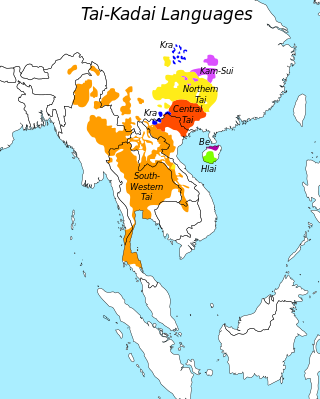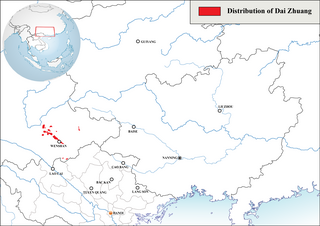Related Research Articles

The Kra–Dai languages are a language family in Mainland Southeast Asia, Southern China and Northeast India. All languages in the family are tonal languages, including Thai and Lao, the national languages of Thailand and Laos respectively. Around 93 million people speak Kra–Dai languages, 60% of whom speak Thai. Ethnologue lists 95 languages in the family, with 62 of these being in the Tai branch.

Lao, sometimes referred to as Laotian, is a Kra–Dai language of the Lao people. It is spoken in Laos, where it is the official language for around 7 million people, as well as in northeast Thailand, where it is used by around 23 million people, usually referred to as Isan. Lao serves as a lingua franca among the citizens of Laos, who also speak approximately 90 other languages, many of which are unrelated to Lao.

Kam Mueang or Northern Thailanguage is the language of the Northern Thai people of Lanna, Thailand. It is a Southwestern Tai language that is closely related to Lao. Kam Mueang has approximately six million speakers, most of whom live in the native Northern Thailand, with a smaller community of Lanna speakers in northwestern Laos.
The Dai people refers to several Tai-speaking ethnic groups living in the Xishuangbanna Dai Autonomous Prefecture and the Dehong Dai and Jingpo Autonomous Prefecture of China's Yunnan Province. The Dai people form one of the 56 ethnic groups officially recognized by the People's Republic of China. By extension, the term can apply to groups in Laos, Vietnam, Thailand and Myanmar when Dai is used to mean specifically Tai Yai, Lue, Chinese Shan, Tai Dam, Tai Khao or even Tai in general. For other names, please see the table below.

The Ahom language or Tai-Ahom language is a dead language, that was spoken by the Ahom people, that is undergoing a revival. Ahom is an important language in Tai studies. It was relatively free of both Mon-Khmer and Indo-Aryan influences and has a written tradition dating back to the 13th century.
The Shan language is the native language of the Shan people and is mostly spoken in Shan State, Myanmar. It is also spoken in pockets in other parts of Myanmar, in Northern Thailand, in Yunnan, in Laos, in Cambodia, in Vietnam and decreasingly in Assam and Meghalaya. Shan is a member of the Tai–Kadai language family and is related to Thai. It has five tones, which do not correspond exactly to Thai tones, plus a sixth tone used for emphasis. The term Shan is also used for related Northwestern Tai languages, and it is called Tai Yai or Tai Long in other Tai languages. Standard Shan, which is also known as Tachileik Shan, is based on the dialect of the city of Tachileik.
Saek is a Tai language spoken in at least ten villages in Khammouane Province, Laos, and at least four villages in Nakhon Phanom Province in northeastern Thailand, just across the Mekong River. It is spoken by the Saek people.
Southern Thai, also known as Dambro, Pak Tai (ภาษาปักษ์ใต้), or "Southern language" (ภาษาใต้), is a Southwestern Tai ethnolinguistic identity and language spoken in southern Thailand as well as by small communities in the northernmost Malaysian states. It is spoken by roughly five million people, and as a second language by the 1.5 million speakers of Pattani and other ethnic groups such as the local Peranakans communities, Negritos, and other tribal groups. Most speakers are also fluent in or understand the Central Thai dialects.

The Vietic languages are a branch of the Austroasiatic language family, spoken by the Vietic peoples in Laos and Vietnam. The branch was once referred to by the terms Việt–Mường, Annamese–Muong, and Vietnamuong; the term Vietic was proposed by La Vaughn Hayes, who proposed to redefine Việt–Mường as referring to a sub-branch of Vietic containing only Vietnamese and Mường.
Khmu[kʰmuʔ] is the language of the Khmu people of the northern Laos region. It is also spoken in adjacent areas of Vietnam, Thailand and China. Khmu lends its name to the Khmuic branch of the Austroasiatic language family, the latter of which also includes Khmer and Vietnamese. Within Austroasiatic, Khmu is often cited as being most closely related to the Palaungic and Khasic languages. The name "Khmu" can also be seen romanized as Kmhmu, Khmu', Kammu, or Khamuk in various publications or alternatively referred to by the name of a local dialect.
Tai Lue or Tai Lɯ, Tai Lü, Thai Lue, Tai Le, Xishuangbanna Dai, is a Tai language of the Lu people, spoken by about 700,000 people in Southeast Asia. This includes 280,000 people in China (Yunnan), 200,000 in Burma, 134,000 in Laos, 83,000 in Thailand and 4,960 in Vietnam. The language is similar to other Tai languages and is closely related to Kham Mueang or Tai Yuan, which is also known as Northern Thai language. In Yunnan, it is spoken in all of Xishuangbanna Dai Autonomous Prefecture, as well as Jiangcheng Hani and Yi Autonomous County in Pu'er City.
Tai Nuea or Tai Nüa is one of the languages spoken by the Dai people in China, especially in the Dehong Dai and Jingpo Autonomous Prefecture in the southwest of Yunnan Province. It is closely related to the other Tai languages. Speakers of this language across the border in Myanmar are known as Shan. It should not be confused with Tai Lü.
Tai Dam, also known as Black Tai, is a Tai language spoken by the Tai Dam in Vietnam, Laos, Thailand, and China.
Phuan or Northeastern Lao is a Tai language spoken in Laos, Thailand and Cambodia.
The Tai Lü people are an ethnic group of China, Laos, Thailand, Burma and Vietnam. They speak a Southwestern Tai language.

Tai Tham script is the name given to an abugida writing system used mainly for a group of Southwestern Tai languages i.e., Northern Thai, Tai Lü, Khün and Lao; as well as the liturgical languages of Buddhism i.e., Pali and Sanskrit. It is historically known as Tua Tham. In Thailand and Myanmar, the script is often referred to as Lanna script in relation to the historical kingdom of Lan Na situating in the Northern region of modern day Thailand and a part of Shan state in Myanmar. Local people in Northern Thailand also call the script as Tua Mueang in parallel to Kam Mueang, a local name for Northern Thai language. In Laos and Isan region of Thailand, a variation of Tai Tham script, often dubbed Lao Tham, is also known by the locals as To Tham Lao or Yuan script. Tai Tham script is traditionally written on a dried palm leaf as a palm-leaf manuscript.

Dai Zhuang or Thu Lao is a Tai language spoken in Yunnan, China and northern Vietnam. In China is it spoken in Yanshan, Wenshan, Maguan, Malipo, Guangnan counties of Wenshan Prefecture. It is also spoken in Honghe Prefecture. The largest concentrations are in Wenshan and Yanshan counties.

The Southwestern Tai, Southwestern Thai or Thailanguages are a branch of the Tai languages of Southeast Asia. Its languages include Siamese, Lanna, Lao, Shan and others.
Sapa, or Tày Sa Pa, is a Southwestern Tai language of Sa Pa, Lào Cai Province, northern Vietnam. According to Pittayaporn (2009) and Glottolog, it is the closest relative of the Southwestern Tai languages, but does not share the phonological innovations that define that group. There are about 300 speakers. Tày Sa Pa speakers are classified by the Vietnamese as ethnic Tay people, most of whom speak Central Tai languages rather than Southwestern Tai languages. According to Jerold Edmondson, the phonology, tones, and lexicon of Tày Sa Pa is similar to that of Standard Thai.

Tai Yo, also known as Tai Mène and Nyaw, is a Tai language of Southeast Asia. It is closely related to Tai Pao of Vietnam, where it may have originated. It was once written in a unique script, the Tai Yo script, but that is no longer in use. The language is known regionally in Laos and Thailand as Tai Mène and Tai Nyaw and, in Vietnam as Tai Do and Tai Quy Chau. Superficially, Tai Yo appears to be a Southwestern Tai language but this is only because of centuries of language contact and it is properly classified with the Northern Tai languages. The Nyaw/Nyo spoken in central Thailand and western Cambodia is not the same as Tai Yo.
References
- ↑ Yong at Ethnologue (18th ed., 2015) (subscription required)
- 1 2 Intajamornrak, Chommanad (April 2019). "Tonal Variation Caused by Language Contact: A Case Study of the Yong Language" (PDF). 13th ICLEHI 2019 Osaka 013-012. Retrieved 12 July 2022.